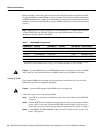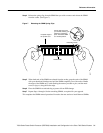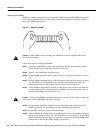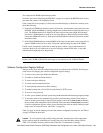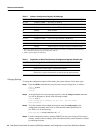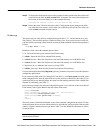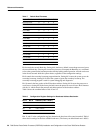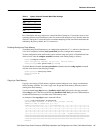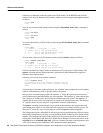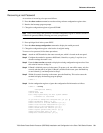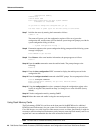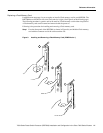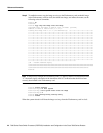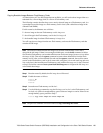
38 7000 Series Route Switch Processor (RSP7000) Installation and Configuration in the Cisco 7000 Series Routers
Reference Information
Following are additional commands related to the Flash memory on the RSP7000 and the Flash
memory cards. You can determine which memory media you are accessing using the pwd command
as follows:
Router# pwd
slot1
You can move between Flash memory media using the cd [bootflash | slot0 | slot1 ] command as
follows:
Router# cd slot0
slot0
Router# cd slot1
Router# pwd
slot1
You can list the directory of Flash memory media using the dir [bootflash | slot0 | slot1 ] command
as follows:
Router# dir
-#- -length- -----date/time------ name
1 4601977 May 19 1994 09:42:19 myfile1
6 679 May 19 1994 05:43:56 todays–config
7 1 May 19 1994 09:54:53 fun1
You can delete a file from any Flash memory media using the delete command as follows:
Router# delete slot0:fun1
Router# dir
-#- -length- -----date/time------ name
1 4601977 May 19 1994 09:42:19 myfile1
6 679 May 19 1994 05:43:56 todays–config
Files that are deleted are simply marked as deleted, but still occupy space in Flash memory. The
squeeze command removes them permanently, and pushes all other undeleted files together to
eliminate spaces between them.
Following is the syntax of the squeeze command:
Router# squeeze slot0:
All deleted files will be removed, proceed? [confirm]
Squeeze operation may take a while, proceed? [confirm]
ebESZ
To prevent loss of data due to sudden power loss, the “squeezed” data is temporarily saved to another
location of Flash memory, which is specially used by the system.
In the previous command display output, the character “e” means this special location has been
erased (which must be performed before any write operation). The character “b” means that the data
that is about to be written to this special location has been temporarily copied. The character “E”
signifies that the sector which was temporarily occupied by the data has been erased. The character
“S” signifies that the data was written to its permanent location in Flash memory.
The squeeze command operation keeps a log of which of these functions has been performed so
upon sudden power failure, it can come back to the right place and continue with the process. The
character “Z” means this log was erased after the successful squeeze command operation.
The configuration register setting 0x0101 tells the system to boot the default image (the first image)
from onboard Flash memory, but does not reset the Break disable or checking for a default netboot
filename. The configuration register setting 0x0102 tells the system to boot from Flash memory if
netboot fails, disable Break, and check for a default netboot filename. For more information on the
copy tftp:filename [ bootflash | slot0 | slot1 ]:filename command, and other related commands, refer
to the set of router products configuration and command reference publications.



